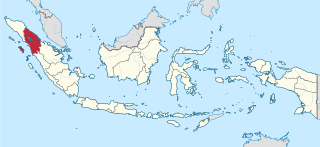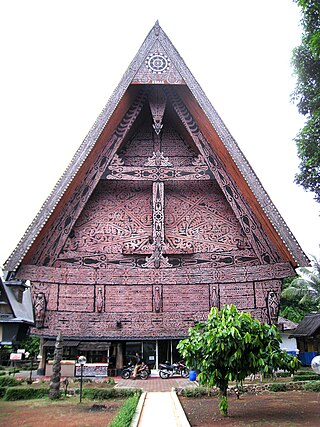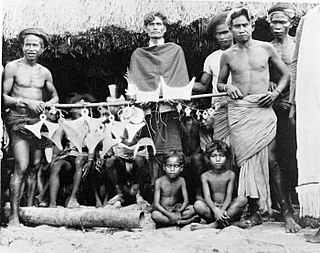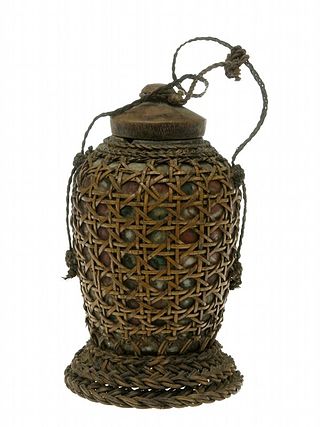
The naga morsarang, also known as sahan, is a container which is used to store medicine in the culture of Toba Batak people of North Sumatra, Indonesia. The naga morsarang is created out of the horn of the water buffalo.

The naga morsarang, also known as sahan, is a container which is used to store medicine in the culture of Toba Batak people of North Sumatra, Indonesia. The naga morsarang is created out of the horn of the water buffalo.
Naga morsarang is one of several types of container in which the datu (Batak people's ritual specialist) kept a supernaturally powerful potion. The naga morsarang is made of horn of a water buffalo. A large naga morsarang vessel measures 20.5 inches (52 cm) long and 10.25 inches (26.0 cm) wide. As a container of a powerful potion, the naga morsarang is extensively decorated with complex patterns. The outer surface is incised thoroughly with complex designs. The pointed end of the horn is carved into the shape of a seated figure of a man, or sometimes more. The opening of the horn is plugged with a wooden stopper. This wooden stopper is always shaped into a figure of the singa, a Naga-like underground figures. Many additional figures are sometimes carved as mounting the singa e.g. the lizard Boraspati ni Tano, a human figure, or several human figures. These human figures may represent the datu, owner of the naga morsarang, and the former datus, former owners of the naga morsarang. Others think that these figures represent characters from Batak mythology. [1]
A figure of a lizard, which represents the earth deity Boraspati ni Tano, is sometimes carved inside the hollow of the horn. [1]

Toba people believed that the spirits of the dead were able to influence the fate of the living. To gain favor from the spirits, the Toba performed elaborate rituals or sacrifices with the help of the datu, a male ritual specialist who acted as intermediaries between the human and supernatural world. The datu created magic books known as the pustaha which was used by him and by his disciples as a reference for his magic rituals. Among the contents of the pustaha are methods to create different kind of potions used for both white magic and black magic in a kind of complex magic ritual. Naga morsarang are used as container for these potions. [2]
One example of a white magic potion is the pagar, a potion used as a kind of amulet to protect from evil. The creation of pagar is very difficult, and can only be done on certain auspicious days. Most of the ingredients of a pagar are derived from plants, although sometimes chicken head, its entrails, and its feathers are included in the mixture. The ingredients for a pagar can only be gathered on certain sacred sites known as the sombaon. Creation of a pagar took days or weeks. All the ingredients are then cooked and finely crushed into a kind of paste which is then stored in the naga morsarang. [2]
The Karo version of the vessel known as perminaken/parminaken or guri-guri. Instead of strictly a bull's horn, the perminaken may use other types of material for the vessel e.g. a bamboo, a gourd, or even a Ming period jar imported from China. [3] The perminaken similarly use a wooden stopper with carvings of a figure of the singa, a person, or a person riding the singa. [4]
The Batak script is a writing system used to write the Austronesian Batak languages spoken by several million people on the Indonesian island of Sumatra. The script may be derived from the Kawi and Pallava script, ultimately derived from the Brahmi script of India, or from the hypothetical Proto-Sumatran script influenced by Pallava.

Medan is the capital and largest city of the Indonesian province of North Sumatra. The nearby Strait of Malacca, Port of Belawan, and Kualanamu International Airport make Medan a regional hub and multicultural metropolis, acting as a financial centre for Sumatra and a gateway to the western part of Indonesia. About 60% of the economy in North Sumatra is backed by trading, agriculture, and processing industries, including exports from its 4 million acres of palm oil plantations. The National Development Planning Agency listed Medan as one of the four main central cities in Indonesia, alongside Jakarta, Surabaya, and Makassar. In terms of population, it is the most populous city in Indonesia outside of the island of Java. Its population as of 2023 is approximately equal to the country of Moldova.

North Sumatra, also called North Sumatra Province, is a province of Indonesia located in the northern part of the island of Sumatra, just south of Aceh. Its capital and largest city is Medan on the east coast of the island. It is bordered by Aceh on the northwest and Riau and West Sumatra on the southeast, by coastlines located on the Indian Ocean to the west, and by the Strait of Malacca to the east.

Batak is a collective term used to identify a number of closely related Austronesian ethnic groups predominantly found in North Sumatra, Indonesia, who speak Batak languages. The term is used to include the Karo, Pakpak, Simalungun, Toba, Angkola, and Mandailing, related ethnic groups with distinct languages and traditional customs (adat).

Apotropaic magic or protective magic is a type of magic intended to turn away harm or evil influences, as in deflecting misfortune or averting the evil eye. Apotropaic observances may also be practiced out of superstition or out of tradition, as in good luck charms, amulets, or gestures such as crossed fingers or knocking on wood. Many different objects and charms were used for protection throughout history.

Singa is an apotropaic figure from the mythology of the Batak people of North Sumatra, Indonesia. The singa represents a benevolent and protective power. The singa is described as "part human, part water buffalo, and part crocodile or lizard". It is variedly represented, but always has an elongated face, with big bulging eyes, a well-defined nose, and long spiraling beard. It is often represented only with its head, but sometimes it may also be represented full body. Other figures - such as other protective deity or ancestral figures - may also be represented standing or sitting on top of the head of the singa.

The Karo, or Karonese, are a people of the Tanah Karo and part of the Karo people from North Sumatra, Indonesia. The Karo lands consist of Karo Regency, plus neighboring areas in East Aceh Regency, Langkat Regency, Dairi Regency, Simalungun Regency, and Deli Serdang Regency. In addition, the cities of Binjai and Medan, both bordered by Deli Serdang Regency, contain significant Karo populations, particularly in the Padang Bulan area of Medan. The town of Sibolangit, Deli Serdang Regency in the foothills of the road from Medan to Berastagi is also a significant Karo town.
A tunggal panaluan is a magic staff used by shamans of the Batak people, who live in the highlands of North Sumatra, Indonesia. Traditionally the tunggal panaluan is made from wood of a specific tree and carved with human figures and embellished with horsehair and cooked human brain, both procured from sacrificial victims.

Patuan Bosar SinambelaginoarOmpu Pulo Batu, better known as Si Singamangaraja XII, was the last priest-king of the Batak peoples of north Sumatra. In the course of fighting a lengthy guerrilla war against the Dutch colonisation of Sumatra from 1878 onwards, he was killed in a skirmish with Dutch troops in 1907. He was declared a National Hero of Indonesia in 1961 for his resistance to Dutch colonialism.

Sigalegale is a wooden puppet used in a funeral dance performance of the Batak people in Samosir Island, Northern Sumatra. Sigale Gale is a well-known feature for visiting tourists. During the dance, the puppet is operated from behind, like a marionette, using strings that run through the ornate wooden platform on which it stands. The setup enables its arms and body to be moved and its head to turn.

Batak architecture refers to the related architectural traditions and designs of the various Batak peoples of North Sumatra, Indonesia. Six groups of Batak speak separate but related languages: the Angkola, the Mandailing to the south, the Toba, to the north the Pakpak/Dairi, the Simalungun, and the Karo. While the groups are now Muslim or Christian, elements of the ancient Batak religion remain, particularly amongst the Karo.
The Mbole people are an ethnic group of about 150,000 people living in the Orientale Province, southwest of Kisangani in the Democratic Republic of the Congo. The Mbole were previously referred to as Bambole.

The mythology of Indonesia is very diverse, the Indonesian people consisting of hundreds of ethnic groups, each with their own myths and legends that explain the origin of their people, the tales of their ancestors and the demons or deities in their belief systems. The tendency to syncretize by overlying older traditions with newer foreign ideas has occurred. For example, the older ancestral mythology might be merged with foreign mythology, such as Hindu, Islam, or Christian biblical mythology.

Nias people are an ethnic group native to Nias, an island off the west coast of North Sumatra, Indonesia. In the Nias language, the Nias people are known as Ono Niha, which means 'descendants of humans'. Nias island is known as Tanö Niha, with Tanö meaning 'land' in the Nias language.

Boraspati ni Tano or Boraspati, also known as Ilik, is the earth deity in Batak mythology. Boraspati ni Tano is represented as a tokay gecko. Images of Boraspati can be found decorating the door of a Batak Karo and Batak Toba buildings as well as other Batak objects e.g. the cover of the pustaha or the pupuk container naga morsarang.

The Great Pustaha is a pustaha displayed in the Tropenmuseum of Amsterdam. The name refers to the largest pustaha which was kept in the museum. The official name for the pustaha is simply "pustaha", but for the purpose of distinction, the pustaha is called the Great Pustaha.

Pustaha is the magic book of the Batak people of North Sumatra, Indonesia. The book contains magical formulas, divinations, recipes, and laws. The pustaha is written and compiled by a Batak magician-priest (datu).

Gorga is a form of artistic decoration found in the culture of Batak Toba in North Sumatra, Indonesia. The gorga motif is in the shape of flourishes and undulations. The motif is either painted or carved onto wood using three colors: white, red, and black; each corresponds with different realms in the Batak Toba cosmology. The Gorga motif is often found in Batak Toba architecture, e.g. a Batak Toba house, or objects, e.g. music instruments. They are meant to protect the building or object from spiritual harm, e.g. evil spirits sent from neighboring village.

Madaka, also written as mendaka, is a type of precious metal valuable to the Sumba people of Sumba Island, Indonesia. It is found in the megalithic culture of the western Sumba people, e.g. the tribe of Anakalang. Of all precious metal valuable to Sumba people, the madaka is considered to be the most sacred type of gold heirloom.

Pupuk is the name given to a magical substance which was used by the Batak shamans of North Sumatra. The pupuk is the main feature to perform black magic, e.g. to inflict damage to enemies. Method of creating the pupuk is inscribed in the pustaha, the magic book of the Toba people, among which involved the kidnapping and murder of a child from neighboring village.